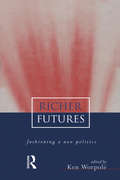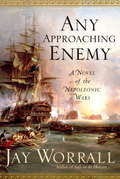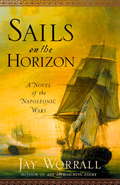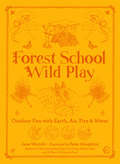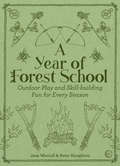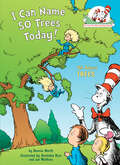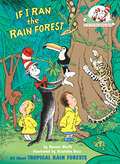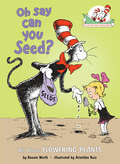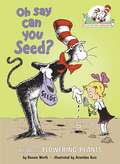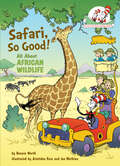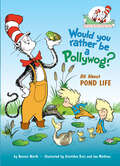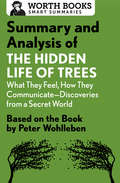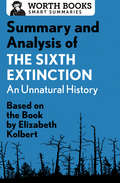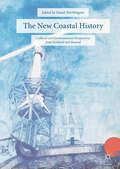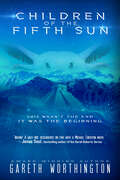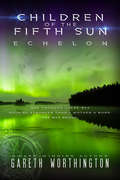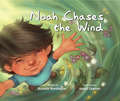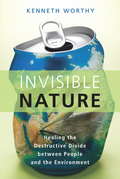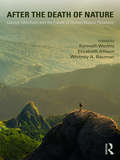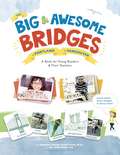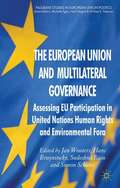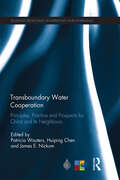- Table View
- List View
The World of the Bobcat (A Living World Book)
by Joe Van WormerCan anybody really "lick his weight in wildcats?" Never, says Joe Van Wormer in this magnificent photo-and- text study of Lynx rufus, better known as the bobcat, or wildcat. In fact, he says, it is extremely doubtful that a 200-pound man could handle the average bobcat, which weighs less than 20 pounds. The bobcat is an elusive and secretive creature, and although he often lives close to civilization, it is impossible to make any prolonged observation of him in the wild. Joe Van Wormer, however, has observed bobcats' dens and followed their trails. He has talked to many people who hunt or own them. He has known a number of domesticated bobcats and has encountered many wild ones, often with the treed cat crouching on one limb and himself, with camera, on another only six or eight feet away. What is the family unit of the bobcat? Where does he live and what does he eat? How does he feel about humans? About his cousin, the house cat? Who are his natural enemies? The informal text and breath-taking photographs are a revelation of the temperament, habits, and lives of these strikingly beautiful nocturnal creatures - whose yellowish eyes, it was once believed, could see through wood and stone.
Richer Futures: Fashioning a new politics (Earthscan Library Collection: Environmental And Resource Economics Set Ser.)
by Ken WorpoleIn every area of life, traditional, centralized party politics has been failing and the seeds of a new form of political life are being sown. This is true in housing, health, education, consumption and transport, where public policy is attracting increasing criticism. In an age of social alienation and urban despondency Richer Futures is a timely response to the growing interest in community-based, self-help action. It introduces new forms of communication and decision-making and sets out a programme for a sustainable politics.Contributions from some of the best-known thinkers and writers on contemporary urban, cultural and social policy (and campaigns) in Britain today pay tribute to the ideas and industrious activities of the influential writer and commentator Colin Ward. This uplifting collection of essays looks forward to a new politics of self-management and environmentally aware and sustainable lifestyles.Ken Worpole has written a number of books on urban and cultural policy, and a series of influential reports for Comedia, Demos and the Department of the Environment.Originally published in 1999
Any Approaching Enemy: A Novel of the Napoleonic Wars
by Jay WorrallWith the stunning high-seas adventure Sails on the Horizon, Jay Worrall introduced a bold new hero in the rousing tradition of Jack Aubrey: Charles Edgemont, an ambitious officer in His Britannic Majesty's navy. Raised to the rank of captain for gallantry under fire, Edgemont proved his mettle in the bruising British victory over the Spanish fleet at the Battle of St. Vincent. Now married and in command of the twenty-eight-gun frigate Louisa, the young captain sails toward a day of destiny-for himself and for England. The year is 1798. The war between England and revolutionary France has reached a bloody stalemate, with England in the ascendancy at sea and France unchallenged on the Continent, thanks in large part to an unorthodox twenty-eight-year-old general named Napoleon Bonaparte. But the French, secretly amassing a powerful fleet, mean to break the impasse. When rumors of the French preparations leak, the Admiralty dispatches a squadron of seven ships-among them the Louisa-under the command of Rear Admiral Horatio Nelson to investigate. Blindsided by a storm of ferocious intensity, the ships scatter across the seas. After the storm subsides, the damaged frigates limp back to the rendezvous point. But there is no sign of Nelson's flagship, Vanguard, nor of two other ships of the line. Edgemont fears that the pugnacious rear admiral has pressed on with the mission. Putting his career on the line by disobeying direct orders, Edgemont sets out in pursuit of Nelson and the French fleet on a treacherous voyage along the Tuscan coast. As tensions among the crew threaten to explode into open insubordination or worse, Edgemont makes an unexpected discovery in Naples that may seriously compromise his mission. When the missing French fleet turns up off the shores of Egypt, conveying an army tens of thousands strong, Edgemont is suddenly thrown into a crisis of conscience. As circumstances grow dire and require heroic action, the fate of the crucial battle effectively lies in Edgemont's hands-as does the course of history. From the Hardcover edition.
Sails on the Horizon: A Novel of the Napoleonic Wars
by Jay WorrallThe year is 1797. Napoleon Bonaparte is racking up impressive wins in the field against the enemies of revolutionary France, while on the seas England is putting up a staunch resistance. Twenty-five-year-old Charles Edgemont is second lieutenant aboard the British ship Argonaut. When orders come for the Argonaut to engage in an all-but-suicidal maneuver to prevent the escape of Spanish ships off the coast of Portugal, he leads his gun crews bravely-until the deaths of the captain and first lieutenant elevate him to commander. For refusing to yield to enemy fire, Charles is permanently promoted and generously rewarded by the Admiralty, becoming wealthy beyond his wildest dreams. Yet upon his return home, his newfound riches prove no help when it comes to winning the heart of Penelope Brown, who regards war as sinful and soldiers as little better than murderers. Changing Penelope's mind may just be the hardest battle Charles has ever fought-at least until fresh orders send him back to sea, where hefaces a formidable adversary in a series of stirring battles of will and might.
Forest School Wild Play
by Jane WorrelAimed at parents, teachers and Forest School leaders, this new book from Jane Worroll & Peter Houghton is packed full of fantastic new Forest School activities. It has a special focus on the elements and on making children feel connected to the natural world through imagination and storytelling. The ultimate antidote to screen time – outdoor play with your kids! Whether you are a parent, a teacher, a Forest School leader or anyone else looking after children, this invaluable guide to nature-based play is full of ideas to get kids outdoors, learning about and connecting with nature, developing new skills and having fun. These new Forest School crafts, games and survival activities are all themed around the elements of earth, air, fire and water, with an underlying message of sustainability and wonder at the amazing web of life. For earth, make a mud slide, try Bogolan mud painting on cloth, or hurl mud missiles at a moving target. For air, make a bullroarer or a whistle, build a kite and fly it, or predict the weather by reading the clouds. For fire, dig a Dakota fire pit, make a bug-repellent torch or learn how to navigate using a shadow stick. For water, mix natural dyes, build and test a rainproof den, or drink foraged birch twig tea from a crafted log cup. There are also four magical stories to tell the children – one for each of the elements –guaranteed to spark their imagination.
A Year of Forest School : Outdoor Play and Skill-building Fun for Every Season
by Jane Worroll Peter HoughtonMore games, crafts and skills Forest School style, building on the success of Play the Forest School Way. This book is organized by season to encourage kids to get outdoors come rain, shine or snow!Following on from the bestselling Play the Forest School Way, here is a brilliant selection of brand-new games, crafts and activities to get kids developing new skills and exploring the natural world all year round. Structured around the four seasons of the year, each chapter is packed full of step-by-step Forest School games and activities that harmonize with the weather and what’s happening in nature at that time of year, with a nod to seasonal festivals such as Easter and Christmas. In spring, for example, you could make a mud birthday cake to celebrate Earth Day on 22 April, or (inspired by bird song) craft sistrums from sticks and bottle tops, or make a clay hare and enjoy dandelion tea and a chocolate egg hunt at a spring day out. At Forest School, children return to the same location again and again, building a lasting connection with a specific part of the natural world, and this book in its year-round approach will bring this aspect of Forest School play to the fore. Each of the four seasonal chapters includes a description of an extended session (combining active and quieter activities plus, for some, an idea for foraging/cooking) to guide Forest School leaders planning themed days and parents looking for party inspiration or nature days out.The Forest School ethos of nature-based play and learning that encourages children to develop confidence, self-esteem and emotional intelligence is exactly what’s needed in an era when childhood problems such as obesity and anxiety are on the rise. Woven through the year are stories from the authors’ own Forest School classes, as they make a passionate case for the importance of ensuring children’s access to nature and the incredible benefits they will gain from being outside, even in the heart of a city.
Rivers of Empire: Water, Aridity, and the Growth of the American West
by Donald WorsterWhen Henry David Thoreau went for his daily walk, he would consult his instincts on which direction to follow. More often than not his inner compass pointed west or southwest. "The future lies that way to me," he explained, "and the earth seems more unexhausted and richer on that side. " In his own imaginative way, Thoreau was imitating the countless young pioneers, prospectors, and entrepreneurs who were zealously following Horace Greeley's famous advice to "go west. " Yet while the epic chapter in American history opened by these adventurous men and women is filled with stories of frontier hardship, we rarely think of one of their greatest problems--the lack of water resources. And the same difficulty that made life so troublesome for early settlers remains one of the most pressing concerns in the western states of the late-twentieth century. The American West, blessed with an abundance of earth and sky but cursed with a scarcity of life's most fundamental need, has long dreamed of harnessing all its rivers to produce unlimited wealth and power. In Rivers of Empire, award-winning historian Donald Worster tells the story of this dream and its outcome. He shows how, beginning in the mid-nineteenth century, Mormons were the first attempting to make that dream a reality, damming and diverting rivers to irrigate their land. He follows this intriguing history through the 1930s, when the federal government built hundreds of dams on every major western river, thereby laying the foundation for the cities and farms, money and power of today's West. Yet while these cities have become paradigms of modern American urban centers, and the farms successful high-tech enterprises, Worster reminds us that the costs have been extremely high. Along with the wealth has come massive ecological damage, a redistribution of power to bureaucratic and economic elites, and a class conflict still on the upswing. As a result, the future of this "hydraulic West" is increasingly uncertain, as water continues to be a scarce resource, inadequate to the demand, and declining in quality. Rivers of Empire represents a radically new vision of the American West and its historical significance. Showing how ecological change is inextricably intertwined with social evolution, and reevaluating the old mythic and celebratory approach to the development of the West, Worster offers the most probing, critical analysis of the region to date. He shows how the vast region encompassing our western states, while founded essentially as colonies, have since become the true seat of the American "Empire. " How this imperial West rose out of desert, how it altered the course of nature there, and what it has meant for Thoreau's (and our own) mythic search for freedom and the American Dream, are the central themes of this eloquent and thought-provoking story--a story that begins and ends with water.
I Can Name 50 Trees Today!: All About Trees (Cat in the Hat's Learning Library)
by Bonnie WorthGet ready to grow and learn all about trees with the Cat in the Hat--a perfect gift for nature lovers on Earth Day and every day! The Cat in the Hat's Learning Library is a nonfiction picture book series that introduces beginning readers ages 5-8 to important basic concepts. The Cat in the Hat and friends explore some of the world&’s most amazing trees, teaching beginning readers how to identify different species from the shape of their crowns, leaves, lobes, seeds, bark, and fruit. Kids will learn about many trees common to North America. Featuring beloved characters from Dr. Seuss's The Cat in the Hat, the Learning Library are unjacketed hardcover picture books that explore a range of nonfiction topics about the world we live in and include an index, glossary, and suggestions for further reading.
If I Ran the Rain Forest: All About Tropical Rain Forests (Cat in the Hat's Learning Library)
by Bonnie WorthThe Cat in the Hat takes Sally and Dick for an “umbrella-vator” ride through the understory, canopy, and emergent layers of a tropical rain forest, encountering a host of plants, animals, and native peoples along the way.
Oh Say Can You Seed?: All About Flowering Plants (Cat in the Hat's Learning Library)
by Bonnie WorthGet ready to bloom and learn all about flowers and plants with the Cat in the Hat--a perfect gift for aspiring gardeners on Earth Day and every day! The Cat in the Hat's Learning Library is a nonfiction picture book series that introduces beginning readers ages 5-8 to important basic concepts. An easy and fun introduction to plant biology! With the able assistance of Thing 1 and Thing 2 - the Cat in the Hat explores the world of plants. Kids will learn about the various parts of plants, seeds, and flowers; basic photosynthesis and pollination; and seed dispersal. Featuring beloved characters from Dr. Seuss's The Cat in the Hat, the Learning Library are unjacketed hardcover picture books that explore a range of nonfiction topics about the world we live in and include an index, glossary, and suggestions for further reading.
Oh Say Can You Seed?: All About Flowering Plants
by Bonnie WorthWith the able assistance of Thing 1 and Thing 2 -- and a fleet of Rube Goldbergian vehicles -- the Cat in the Hat examines the various parts of plants, seeds, and flowers; basic photosynthesis and pollination; and seed dispersal.
Safari, So Good!: All About African Wildlife (Cat in the Hat's Learning Library)
by Bonnie WorthIn this latest installment of the Cat in the Hat's Learning Library, the Cat takes Sally and Nick to Africa—where they meet some really big cats—and all sorts of other animals, too, including elephants, zebra, giraffe, hippos, warthogs, buffalo, baboons, side-striped jackals, spotted hyena, galagos, pythons, vipers, and six kinds of antelope! Young readers will learn how animals are either predators or prey, that elephants tend to favor one tusk over the other, how to tell the difference between a white and black rhino (both of which are grey!), that lion cubs are born covered with spots that soon disapear, and much, much more! Fans of the new PBS preschool science show The Cat in the Hat Knows a Lot About That! (which is based on The Cat in the Hat's Learning Library) won't want to miss this wild new addition to the series!
Would You Rather Be a Pollywog: All About Pond Life (Cat in the Hat's Learning Library)
by Bonnie WorthCats normally don't like water, but the Cat in the Hat is no normal puss! He’s fond of ponds, and in this latest Cat in the Hat’s Learning Library book, he takes Sally and Dick on a trip to show them how ponds are fascinating places teeming with life.From algae to snails, leeches, insects, fish, frogs, newts, turtles, ducks, swans, and more, the Cat explains how all different kinds of plants and animals make their home in and around ponds, as well as examining the difference between complete and incomplete metamorphosis and the various stages of frog development. Ideal for spring and summer reading, this is a beginning reader that will inspire kids to get outside and explore!
Summary and Analysis of The Hidden Life of Trees: Based on the Book by Peter Wohlleben (Smart Summaries)
by Worth BooksSo much to read, so little time? This brief overview of The Hidden Life of Trees tells you what you need to know—before or after you read Peter Wohlleben&’s book. Crafted and edited with care, Worth Books set the standard for quality and give you the tools you need to be a well-informed reader. This short summary and analysis of The Hidden Life of Trees includes: Historical contextChapter-by-chapter overviewsProfiles of the main charactersImportant quotesFascinating triviaGlossary of termsSupporting material to enhance your understanding of the original work About The Hidden Life of Trees by Peter Wohlleben: The Hidden Life of Trees explains the astonishing ways trees interact with each other and respond to their environment. It details how they communicate via underground fungal networks, provide sugar to help trees that are stressed, warn each other of insect or fungal attacks, and coordinate their growth and reproduction. The author also describes how forestry methods can be improved to work with this complex inter-tree network to allow for healthier trees. Naturalist Peter Wohlleben puts into context the invaluable role forests play in sequestering carbon, talks about the contribution that large, old trees can play in battling climate change, and how caring for woodlands is vital to all life on earth. The summary and analysis in this ebook are intended to complement your reading experience and bring you closer to a great work of nonfiction.
Summary and Analysis of The Sixth Extinction: Based on the Book by Elizabeth Kolbert (Smart Summaries)
by Worth BooksSo much to read, so little time? This brief overview of The Sixth Extinction tells you what you need to know—before or after you read Elizabeth Kolbert&’s book. Crafted and edited with care, Worth Books set the standard for quality and give you the tools you need to be a well-informed reader. This short summary and analysis of The Sixth Extinction: An Unnatural History by Elizabeth Kolbert includes: Historical contextChapter-by-chapter overviewsDetailed timeline of key eventsImportant quotesFascinating triviaGlossary of termsSupporting material to enhance your understanding of the original work About The Sixth Extinction by Elizabeth Kolbert: Our planet has endured five events of mass extinction, from centuries of catastrophic heating and cooling to the asteroid that fell to earth and ended the Cretaceous Period. We are currently facing the sixth extinction, and this time the human species is to blame. Elizabeth Kolbert travels the world and meets with scientists who are grappling with the ecological outcomes of human activity. Her Pulitzer Prize–winning modern science classic tells the stories of thirteen different species that have already disappeared or are on the brink of extinction as a result of human activity. A captivating blend of research and historical anecdotes enlightens readers about the unintentional consequences of our behaviors, from climate change and global warming to invasive species and overexploitation. The summary and analysis in this ebook are intended to complement your reading experience and bring you closer to a great work of nonfiction.
The New Coastal History
by David WorthingtonThis book provides a pathway for the New Coastal History. Our littorals are all too often the setting for climate change and the political, refugee and migration crises that blight our age. Yet historians have continued, in large part, to ignore the space between the sea and the land. Through a range of conceptual and thematic chapters, this book remedies that. Scotland, a country where one is never more than fifty miles from saltwater, provides a platform as regards the majority of chapters, in accounting for and supporting the clusters of scholarship that have begun to gather around the coast. The book presents a new approach that is distinct from both terrestrial and maritime history, and which helps bring environmental history to the shore. Its cross-disciplinary perspectives will be of appeal to scholars and students in those fields, as well as in the environmental humanities, coastal archaeology, human geography and anthropology.
Children of the Fifth Sun (Children of the Fifth Sun #1)
by Gareth WorthingtonGenre: “Science Faction” - science fiction, action and adventure with fact-based science, theories, and mythologyIN ALMOST EVERY BELIEF SYSTEM ON EARTH, there exists a single unifying mythos: thousands of years ago a great flood devastated the Earth's inhabitants. From the ruins of this cataclysm, a race of beings emerged from the sea bestowing knowledge and culture upon humanity, saving us from our selfish drive toward extinction. Some say this race were “ancient aliens” who came to assist our evolution.But what if they weren't alien at all? What if they evolved right here on Earth, alongside humans . . . and they are still here? And, what if the World's governments already know?***Kelly Graham is a narcissistic self-assured freelance photographer specializing in underwater assignments. While on a project in the Amazon with his best friend, Chris D'Souza, a mysterious and beautiful government official, Freya Nilsson, enters Kelly's life and turns it upside down. Her simple request to retrieve a strange object from deep underwater puts him in the middle of an international conspiracy. A conspiracy that threatens to change the course of human history.AwardsWinner — 2017 London Book Festival — Science FictionFinalist — 2018 Silver Falchion Award — SciFi/Fantasy/HorrorFinalist — 2019 First Horizon Award, The Eric Hoffer Book AwardShort List Finalist — 2019 Eric Hoffer Grand Prize AwardHonorable Mention — 2019 Eric Hoffer Book Awards in Science FictionSemi-Finalist — 2018 Chanticleer International Book Awards
Echelon (Children of the Fifth Sun)
by Gareth WorthingtonShe thought there was nothing stronger than a mother’s bond. She was wrong.FIFTEEN THOUSAND YEARS AGO, the knowledge bringers—an amphibious, non-humanoid species known as the Huahuqui—came after a great global flood, gifting humans with math, science, and civility.We killed them all.Seventy years ago, we found one of their corpses preserved in ice and eventually created a clone named K’in. Our governments fought over the creature and we killed it, too. Now, a sinkhole in Siberia has opened, revealing new secrets.FREYA NILSSON spent the last five years trying to forget her role in the Huahuqui cloning program. She hid her son, KJ, from the regimes and agencies she believed would exploit him for the powers he acquired through his father’s bond with K’in.An innocent trip to help KJ understand his abilities results in the conspiracy she fought to bury exploding back to life. Chased by new foes and hounded to put the world first, all Freya can think of is protecting KJ—at all costs.Children of the Fifth Sun: Echelon is the sequel to Gareth Worthington’s multi-award-winning debut novel Children of the Fifth Sun.
Noah Chases the Wind
by Michelle Worthington Joseph CowmanNoah knew he was different. He could see things that others couldn't, like the patterns in the dust that floated down on sunbeams.Noah is different. He sees, hears, feels, and thinks in ways that other people don't always understand, and he asks a lot of questions along the way. Noah loves science, especially the weather. His books usually provide him with the answers he needs, until one day, there's one question they don't answer-and that is where Noah's windy adventure begins.Filled with rich, sweeping illustrations, this picture book celebrates the inquisitive nature of all children, including those on the autism spectrum, who cannot stop asking a question until an answer has been unearthed.The book contains a page of information for parents, caregivers, and educators about the importance of helping children feel good about their differences and know that being different is okay.Michelle Worthington was born in Brisbane, Queensland, and has lived there all her life. She is much-published author in Australia.Joseph Cowman lives and paints in the hills and valleys of suburban Idaho. He is a long-standing member of the Society of Children's Books Writers and Illustrators. He is the illustrator of six other Redleaf Lane books, including most recently, The Amazing Erik and Rita and the Firefighters.
Invisible Nature
by Kenneth WorthyA revolutionary new understanding of the precarious modern human-nature relationship and a path to a healthier, more sustainable world.Amidst all the wondrous luxuries of the modern world--smartphones, fast intercontinental travel, Internet movies, fully stocked refrigerators--lies an unnerving fact that may be even more disturbing than all the environmental and social costs of our lifestyles. The fragmentations of our modern lives, our disconnections from nature and from the consequences of our actions, make it difficult to follow our own values and ethics, so we can no longer be truly ethical beings. When we buy a computer or a hamburger, our impacts ripple across the globe, and, dissociated from them, we can't quite respond. Our personal and professional choices result in damages ranging from radioactive landscapes to disappearing rainforests, but we can't quite see how. Environmental scholar Kenneth Worthy traces the broken pathways between consumers and clean-room worker illnesses, superfund sites in Silicon Valley, and massively contaminated landscapes in rural Asian villages. His groundbreaking, psychologically based explanation confirms that our disconnections make us more destructive and that we must bear witness to nature and our consequences. Invisible Nature shows the way forward: how we can create more involvement in our own food production, more education about how goods are produced and waste is disposed, more direct and deliberative democracy, and greater contact with the nature that sustains us.
After the Death of Nature: Carolyn Merchant and the Future of Human-Nature Relations
by Kenneth Worthy Elizabeth Allison Whitney A. BaumanCarolyn Merchant’s foundational 1980 book The Death of Nature: Women, Ecology, and the Scientific Revolution established her as a pioneering researcher of human-nature relations. Her subsequent groundbreaking writing in a dozen books and over one hundred peer-reviewed articles have only fortified her position as one of the most influential scholars of the environment. This book examines and builds upon her decades-long legacy of innovative environmental thought and her critical responses to modern mechanistic and patriarchal conceptions of nature and women as well as her systematic taxonomies of environmental thought and action. Seventeen scholars and activists assess, praise, criticize, and extend Merchant’s work to arrive at a better and more complete understanding of the human place in nature today and the potential for healthier and more just relations with nature and among people in the future. Their contributions offer personal observations of Merchant’s influence on the teaching, research, and careers of other environmentalists.
The Big and Awesome Bridges of Portland and Vancouver: A Book for Young Readers and Their Teachers
by Sharon Wood Wortman Ed WortmanThe big & awesome bridges of Portland & Vancouver is a book that gets young people excited about science and engineering and provides teachers a comprehensive resource for developing engaging elementary school units of study, all through an exploration of one of the most diverse and historic collections of big river bridges in the world.
The Complete Book of Essential Oils and Aromatherapy
by Valerie Ann WorwoodEssential oils are one of the world's great untapped resources. This complete volume explains how to incorporate these ancient medicines of the earth into everyday life for personal care, physical and mental health, and a safe home environment. It gives more than 500 recipes using essential oils as alternatives to often toxic human-made health, beauty, and cleaning products.
The European Union and Multilateral Governance
by Jan Wouters Hans Bruyninckx Sudeshna Basu Simon SchunzAn interdisciplinary approach to the study of the EU in UN human rights and environmental governance which addresses the legal and political science dimensions. With contributions from academics and policy-makers, this volume is a comprehensive analysis of how the challenges it faces impact on the EU's position in UN fora.
Transboundary Water Cooperation: Principles, Practice and Prospects for China and Its Neighbours (Routledge Special Issues on Water Policy and Governance)
by Patricia Wouters Huiping Chen James E. NickumChina and its neighbours face a series of water security issues, in which international law plays a vital role. Paramount to both policymakers and researchers in the field of water law, the current status of transboundary water cooperation schemes and how these operate in China is of global significance. Grounded in international experience, this comprehensive volume provides readers with an up-to-date overview of current international transboundary water resource sharing policies and practices, including detailed case studies at both domestic and international levels. The authors discuss existing international laws, treaties, and principles that may stimulate transboundary water cooperation and dialogue, and then analyse a number of international experiences with treaties in North America, Eastern Europe, and Central Asia. They take stock of China’s water resource issues, legal practices and options, examine case studies of China’s southern shared rivers, and explore some innovative approaches to cooperative management of shared waters within China. The articles in this book were originally published in the journal Water International.

